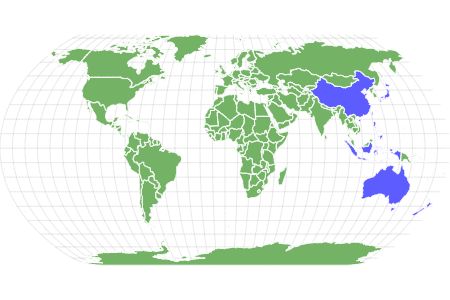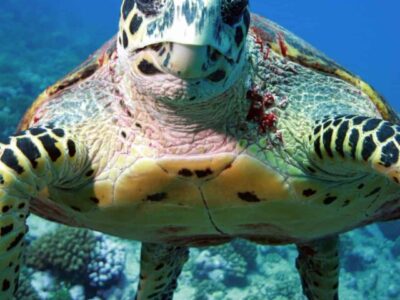The largest recorded specimen ever caught was 17" long
Advertisement
Neptune Grouper Scientific Classification
- Kingdom
- Animalia
- Phylum
- Chordata
- Class
- Actinopterygii
- Order
- Perciformes
- Family
- Serranidae
- Genus
- Cephalopholis
- Scientific Name
- Cephalopholis igarashiensis
Read our Complete Guide to Classification of Animals.
Neptune Grouper Conservation Status
Neptune Grouper Facts
- Prey
- Other fish, squids, and crustaceans
- Group Behavior
- Solitary
- Territorial
- Fun Fact
- The largest recorded specimen ever caught was 17" long
- Estimated Population Size
- N/A
- Biggest Threat
- None
- Most Distinctive Feature
- Colorful red and yellow patterns
- Other Name(s)
- Garish hind, goldbar grouper, Japanese cod, Indian mibai
- Optimum pH Level
- 7.5-8.5
- Habitat
- Deep ocean
- Predators
- Other groupers, barracuda, king mackerel, moray eels, sharks and other fish, humans
- Diet
- Carnivore
- Type
- Fish (seranid)
- Common Name
- Neptune grouper
- Number Of Species
- 1
View all of the Neptune Grouper images!
The Neptune grouper is a rare, hard-to-catch marine species of ray-finned fish.
The Neptune grouper lives mainly in the deep waters of the Western Pacific Ocean and among the coral reefs of the Indo–Pacific. The price of the fish ranges between $6,000-8,000. It is known in Asia for its bright red and yellow patterns and used in recipes such as sashimi.
3 Neptune Grouper Facts
- Because it is so rare, its price is very expensive
- It is very difficult to catch because it is a deep ocean fish and needs decompression after fishing to avoid dying before reaching the surface
- It is one of the smaller groupers in terms of size
Neptune Grouper Classification and Scientific Name
As a ray-finned fish, the Neptune grouper is in the class Actinopterygii. It is in the order Perciformes, of which 41% are bony fishes, including the Neptune grouper. It is in the family Serranidae, which includes the groupers, soapfishes, and sea basses in 450 species and 65 genera. Its genus Cephalopholis includes the groupers, anthias and sea basses. Japanese ichthyologist Masao Katayama was the first person to formally describe Cephalopholis igarashiensis in 1957. There is 1 species of Neptune grouper.
Neptune Grouper Appearance
The size of this grouper species is considered small in comparison to other groupers, which are generally considered big fish. It has a small head with a large body in proportion and its body is flattened vertically, with a pattern of vivid red and yellow or reddish orange and 7 wide, bright yellow on its upper sides that extend onto the dorsal fin, plus 3 wide yellow irregular stripes on the sides of its head. Its dorsal fin has 9 spines and 14 soft rays and the anal fin has 3 spines and 9 soft rays, while the caudal fin is round.
While it first seems that bright colors would be a disadvantage for an animal that is not venomous, it is not true for the Neptune grouper. Coral reefs are brightly colored, and those in the Indo–Pacific are more diverse than in anywhere else. Their colors can be golden brown, bright blue, green, or red. With the Neptune grouper being reddish-orange or red and yellow in a striped pattern, it’s a great camouflage against predators.
Size-wise, its length measures 2.0 to 2.4 times the body’s depth. Its average length is 10in with a maximum of 18in.
Juveniles are more yellow. They also have darker lower bodies and fins, many white stripes and a big black eyespot on the soft rays of its dorsal fin.
Neptune Grouper Distribution, Population, and Habitat
The Neptune grouper is a marine (sea-dwelling) and demersal (groundfish) species. It has a depth range of 64-250m and does not migrate. Its geographic range extends from Australia and several islands off New Zealand, in Oceania, and the Pacific Ocean to southern Japan, Taiwan, Guam, the Philippines, South China Sea, Indonesia, Timor-Leste, Palau, Samoa, and Tahiti in French Polynesia. Its population trend is unknown and it is listed as Least Concern on the IUCN Red List.
Where to find Neptune grouper and how to catch it
You can catch the Neptune grouper with a simple hook and sinker style rig. The best bait for it is live or dead shrimp, squid, ballyhoo, sardines, grunts, and bonito, but lures work as well. This fish is very difficult to catch alive, however. You can’t simply catch it with nets, because it is very likely to die of decompression sickness before it reaches the surface. It is extremely rare to find one has made it to the surface and was able to be caught alive.
The only way to catch it alive is by using a submarine that can go to its depth, catching it, and placing it in a storage tank. The submarine must then slowly ascend and wait at each interval so it can acclimate the fish to the pressure. Only a handful of the fish come to the aquarium market alive every year for sale. Most go to scientific institutes and national aquariums, leaving even fewer for consumer aquarists to get a chance to buy them. It’s possible to go many years without hearing of any for sale. On the other hand, they are often sold at fish markets, just not alive.
Neptune Grouper Predators and Prey
The Neptune grouper’s diet is carnivorous. It is predatory and catches prey by targeting slower-moving animals, ambush, or drawing water into its mouth like a vaccuum. There are no threats to its particular species, but overfishing is a major threat for coral reef fish, including groupers.
What does Neptune grouper eat?
Neptune groupers eat other fish, squids, and crustaceans.
What eats Neptune grouper?
Larger fish eat Neptune grouper, including other groupers, barracuda, king mackerel, moray eels, and sharks. Humans also eat Neptune grouper.
Neptune Grouper Reproduction and Lifespan
Very little information is known about this specific grouper’s reproduction, life cycle, and lifespan. However, like other groupers, it reproduces through dispersal spawning, meaning sperm and eggs are released and mixed together in the water column. There is a planktonic larval stage the hatchlings stay in for a number of weeks. Certain species, like the Goliath grouper, start off as female with a few becoming male if they survive and become larger, and can live 30-50 years.
Neptune Grouper in Fishing and Cooking
This species is popular in game and subsistence fishing. At a fish market, it is likely to be sold whole on ice for a price of about $50. In Japan, it is popular in recipes such as sashimi. Like other groupers, it has a light, sweet, very mild flavor between sea bass and halibut and large, chunky flakes that are similar in texture to lobster or crab. It easily absorbs dressings and marinades. Nutrition-wise, it is low in calories and high in protein and potassium, and a good source of iron and Vitamin A. On the other hand, groupers are high-mercury fish.
Some popular grouper recipes are:
View all 65 animals that start with NNeptune Grouper FAQs (Frequently Asked Questions)
How big do Neptune groupers get?
They are 10 inches on average, but can grow to be 18 inches long.
Do Neptune groupers live in saltwater?
Yes, they live in deep temperate and tropical marine waters.
Where do Neptune groupers live?
They live in the Pacific Ocean.
What do Neptune groupers eat?
They eat other fish, squids, and crustaceans.
Thank you for reading! Have some feedback for us? Contact the AZ Animals editorial team.


















